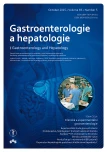Quality of biopsies in patients with Barrett’s esophagus – jumbo vs. large capacity forceps
Authors:
M. Kollár 1; J. Malušková 1; J. Krajčíová 2; Z. Vacková 2; J. Špičák 2; J. Martínek 2
Authors‘ workplace:
Pracoviště klinické a transplantační patologie, Transplantcentrum, IKEM, Praha
1; Klinika hepatogastroenterologie, Transplantcentrum, IKEM, Praha
2
Published in:
Gastroent Hepatol 2015; 69(5): 431-436
Category:
Clinical and Experimental Gastroenterology: Original Article
doi:
https://doi.org/10.14735/amgh2015431
Overview
Good quality of biopsy specimen is a precondition for a reliable diagnosis of early neoplasia in patients with Barrett’s oesophagus. Studies comparing large capacity vs. jumbo forceps have yielded inconsistent results. The aim of this study was to assess the quality of biopsy specimen obtained by two different-sized biopsy forceps: Radial Jaw 4 (RJ4) large capacity (outer diameter 2.4 mm) vs. RJ4 jumbo (outer diameter 2.8 mm) in patients with Barrett’s oesophagus. We hypothesised that RJ4 jumbo forceps used with a standard diagnostic endoscope (channel 2.8 mm) provides a better quality of biopsy specimen as compared to the large capacity forceps.
Methods:
A single-centre, randomised (forceps order), prospective and single blind study (blinded by a pathologist). There were enrolled 21 patients with Barrett’s oesophagus (5 women, 16 men). All patients underwent upper gastrointestinal endoscopy with trimodal imaging. Targeted or random biopsies were obtained with both forceps in a random order from each patient during a single endoscopy with a diagnostic endoscope. The main outcome measurement was specimen adequacy (defined as a well oriented biopsy specimen of 2 mm or larger with mucosa present).
Results:
A total of 288 biopsy samples were analysed (large capacity forceps: 159, jumbo forceps: 129). A significantly higher proportion of biopsy samples obtained with jumbo forceps was adequate as compared to those obtained with large capacity forceps (54.3% vs. 18.9%, p < 0.0001). Biopsies obtained with jumbo forceps had a larger diameter (median 2.4 mm (P10 = 1.8, P90 = 3.6) vs. 2 mm; (P10 = 1.4, P90 = 3.01) p < 0.001). The muscularis mucosae layer was detected in 67.4% of specimens obtained with jumbo forceps vs. 31.4% of those obtained with large capacity forceps (p < 0.0001). Excellent or good specimen orientation was present in 79.8% of samples with jumbo forceps and in 59.1% with large capacity forceps (not significant). Intestinal metaplasia was present in 69.8% with jumbo forceps vs. 78.6% of samples with large capacity (not significant). The diagnostic yield of both types of forceps was comparable. No complications related to biopsy samples were detected.
Conclusions:
RJ4 jumbo biopsy forceps used with diagnostic endoscope provides more adequate biopsy specimen as compared to RJ4 large capacity biopsy forceps.
Key words:
Barrett’s oesophagus – biopsy forceps – jumbo forceps – large capacity forceps
The authors declare they have no potential conflicts of interest concerning drugs, products, or services used in the study.
Editorial Board declares that the manuscript met the ICMJE „uniform requirements“ for biomedical papers.
Submitted:
24. 9. 2015
Accepted:
28. 9. 2015
Sources
1. Sharma P. Clinical practice. Barrett’s esophagus. N Engl J Med 2009; 361(26): 2548–2556. doi: 10.1056/NEJMcp0902173.
2. Spechler SJ, Sharma P, Souza RF et al. American Gastroenterological Association medical position statement on the management of Barrett’s esophagus. Gastroenterology 2011; 140(3): 1084–1091. doi: 10.1053/j.gastro.2011.01.030.
3. Komanduri S, Swanson G, Keefer L et al. Use of a new jumbo forceps improves tissue acquisition of Barrett’s esophagus surveillance biopsies. Gastrointest Endosc 2009; 70(6): 1072–1078. doi: 10.1016/j.gie.2009.04.009.
4. Fitzgerald RC, di Pietro M, Ragunath K et al. British Society of Gastroenterology guidelines on the diagnosis and management of Barrett’s esophagus. Gut 2014; 63(1): 7–42. doi: 10.1136/gutjnl-2013-305372.
5. Martinek J, Maluskova J, Stefanova M et al. Improved specimen adequacy using jumbo biopsy forceps in patients with Barrett’s esophagus. World J Gastroenterol 2015; 21(17): 5328–5335. doi: 10.3748/wjg.v21.i17.5328.
6. Gonzales S, Yu WM, Smith MS et al. Randomized comparison of 3 different-sized biopsy forceps for quality of sampling in Barrett’s esophagus. Gastrointest Endosc 2010; 72(5): 935–940. doi: 10.1016/j.gie.2010.07.035.
7. ASGE Standards of Practice Committee, Evans JA, Early DS et al. The role of endoscopy in Barrett’s esophagus and other premalignant conditions of the esophagus. Gastrointest Endosc 2012; 76(6): 1087–1094. doi: 10.1016/j.gie.2012.08.004.
Labels
Paediatric gastroenterology Gastroenterology and hepatology SurgeryArticle was published in
Gastroenterology and Hepatology

2015 Issue 5
Most read in this issue
- Endoscopic histologisation of diminutive colorectal polyps. Are we ready for a change?
- Screening colonoscopy among elderly patients over 70 years
- Home parenteral nutrition – its importance and use in clinical practice
- First experience with digital Spyglass™ DS in Slovakia from the gastroenterology department of the Trnava University Hospital
